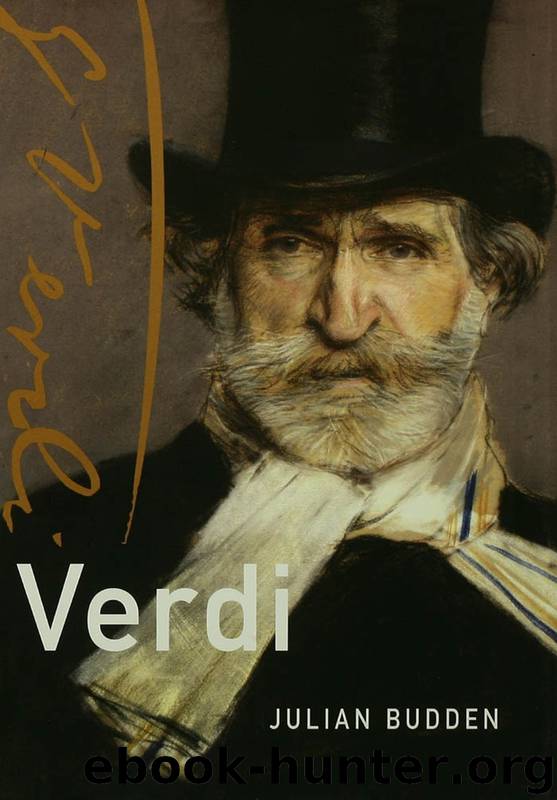Verdi by Budden Julian;

Author:Budden, Julian;
Language: eng
Format: epub
Publisher: Oxford University Press, Incorporated
Published: 2008-08-19T16:00:00+00:00
The duet with Alzira, introduced by an excited pounding over a dominant pedal, consists of two allegro movements only—surely the most perfunctory love duet in opera. In the course of the finale to Act I Zamoro taunts Gusman with a stanza (‘Teco sperai combattere’) which irresistibly brings to mind Edgardo’s curse from Lucia di Lammermoor and with good reason, since it was in this role that Zamoro’s creator, Gaetano Fraschini, had earned for himself the soubriquet ‘il tenore della maledizione’. In general it would seem that Verdi’s melodic inventiveness was sorely tested by Cammarano’s spaciously conceived arias; and he compensated for lyrical breadth with swiftness of action. The result is an opera with the brevity of I due Foscari but without its charm.
Yet Alzira is not without its memorable moments. There are two essays in imaginative scoring: a section of the overture for high woodwind and percussion of a distinctly exotic colour, and a prelude in Act II descriptive of the lonely cavern in which the Incas have taken refuge. Both finales are impressive; the first with its gradual build-up of voices, first singly then in pairs; the second with the baritone line of Gusman running like a golden thread through the choral and orchestral tapestry. But they are not enough to restore the opera to the repertory—if indeed it can ever have been said to have entered it.
Attila (1846) is the last in the line of homespun ‘grand’ operas which began with Nabucco. So long as it had been intended for Piave Verdi had been disposed to take charge of the dramatic scheme; but once Solera had taken over he was only too ready to rely on the judgment of a librettist whose formulae had never yet failed with the public. Solera freely manipulated the events of Zacharias Werner’s turgid drama, turning it into a vehicle for Italian—and more specifically Venetian—patriotism. To the opening scene, set during the sack of Aquileia, he added another showing the founding of Venice on the mudflats of the Adriatic lagoon. The two principal scenes—Attila turned back from the gates of Rome by Pope Leo, and the banquet at which the heroine thwarts a plot to poison Attila since she wants to stab him herself on their wedding night—are placed in that order, contrary to Werner’s scheme. The heroine herself, the Burgundian Hildegonde, becomes the Italian warrior-maid Odabella; the tenor hero is the historical Aquileian knight Foresto; Attila’s chief adversary and baritone lead remains the treacherous if patriotic Roman general Ezio. Attila himself is a bass role written for Ignazio Marini, creator of Oberto.
Here at least was a subject far better suited to Verdi’s early manner than Alzira; and indeed within the blunt, not to say bludgeoning style there is considerable progress in melodic craftsmanship even where inspiration is lacking. Odabella’s cantabile of defiance (‘Allor che i forti corrono’) and Foresto’s ‘Ella in poter del barbaro!’ are conceived on an unusually large scale, the opening phrase of each yielding three variants so graded as to produce a particularly strong climax towards the final cadence.
Download
This site does not store any files on its server. We only index and link to content provided by other sites. Please contact the content providers to delete copyright contents if any and email us, we'll remove relevant links or contents immediately.
The Goal (Off-Campus #4) by Elle Kennedy(13193)
Kathy Andrews Collection by Kathy Andrews(11323)
Diary of a Player by Brad Paisley(7267)
What Does This Button Do? by Bruce Dickinson(5932)
Assassin’s Fate by Robin Hobb(5854)
Big Little Lies by Liane Moriarty(5512)
Altered Sensations by David Pantalony(4866)
Pale Blue Dot by Carl Sagan(4613)
Sticky Fingers by Joe Hagan(3911)
The Death of the Heart by Elizabeth Bowen(3337)
The Heroin Diaries by Nikki Sixx(3318)
Beneath These Shadows by Meghan March(3149)
Confessions of a Video Vixen by Karrine Steffans(3100)
The Help by Kathryn Stockett(3018)
How Music Works by David Byrne(2963)
Jam by Jam (epub)(2876)
Harry Potter 4 - Harry Potter and The Goblet of Fire by J.K.Rowling(2801)
Strange Fascination: David Bowie: The Definitive Story by David Buckley(2701)
Petty: The Biography by Warren Zanes(2574)
